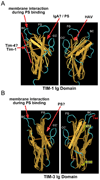T cell Ig and mucin domain proteins and immunity
- PMID: 20200285
- PMCID: PMC3069641
- DOI: 10.4049/jimmunol.0902937
T cell Ig and mucin domain proteins and immunity
Abstract
Proteins of the transmembrane (or T cell) Ig and mucin domain (TIM) family are expressed by multiple cell types within the immune systems of rodents and humans. Studies over the last several years have suggested that these proteins may be promising targets for therapeutic manipulation of immune responses. This review discusses the progress that has been made in understanding TIM protein function in the immune system, as well as some of the unresolved issues that remain on the road to eventually targeting TIM proteins for enhancing or inhibiting immunity.
Figures


Similar articles
-
Defect in regulatory B-cell function and development of systemic autoimmunity in T-cell Ig mucin 1 (Tim-1) mucin domain-mutant mice.Proc Natl Acad Sci U S A. 2012 Jul 24;109(30):12105-10. doi: 10.1073/pnas.1120914109. Epub 2012 Jul 5. Proc Natl Acad Sci U S A. 2012. PMID: 22773818 Free PMC article.
-
T-cell Ig and mucin domain-containing protein (Tim)-2 regulates murine allergic conjunctivitis during the effector phase.Immunol Lett. 2007 Jun 15;110(2):133-8. doi: 10.1016/j.imlet.2007.04.005. Epub 2007 May 15. Immunol Lett. 2007. PMID: 17532058
-
TIM-4 is the ligand for TIM-1, and the TIM-1-TIM-4 interaction regulates T cell proliferation.Nat Immunol. 2005 May;6(5):455-64. doi: 10.1038/ni1185. Epub 2005 Mar 27. Nat Immunol. 2005. PMID: 15793576
-
Structure and Functions of T-cell Immunoglobulin-domain and Mucin- domain Protein 3 in Cancer.Curr Med Chem. 2022;29(11):1851-1865. doi: 10.2174/0929867328666210806120904. Curr Med Chem. 2022. PMID: 34365943 Review.
-
T-cell immunoglobulin and mucin-domain containing-3 (TIM-3): Solving a key puzzle in autoimmune diseases.Int Immunopharmacol. 2023 Aug;121:110418. doi: 10.1016/j.intimp.2023.110418. Epub 2023 Jun 6. Int Immunopharmacol. 2023. PMID: 37290326 Review.
Cited by
-
TIM-3 Regulates Distinct Functions in Macrophages.Front Immunol. 2016 Jun 13;7:229. doi: 10.3389/fimmu.2016.00229. eCollection 2016. Front Immunol. 2016. PMID: 27379093 Free PMC article. Review.
-
Enhancement of SIV-specific cell mediated immune responses by co-administration of soluble PD-1 and Tim-3 as molecular adjuvants in mice.Hum Vaccin Immunother. 2014;10(3):724-33. doi: 10.4161/hv.27340. Epub 2013 Dec 10. Hum Vaccin Immunother. 2014. PMID: 24326266 Free PMC article.
-
Synergistic effect of IL-12 and IL-18 induces TIM3 regulation of γδ T cell function and decreases the risk of clinical malaria in children living in Papua New Guinea.BMC Med. 2017 Jun 15;15(1):114. doi: 10.1186/s12916-017-0883-8. BMC Med. 2017. PMID: 28615061 Free PMC article.
-
Role of TIM-4 in exosome-dependent entry of HIV-1 into human immune cells.Int J Nanomedicine. 2017 Jul 6;12:4823-4833. doi: 10.2147/IJN.S132762. eCollection 2017. Int J Nanomedicine. 2017. PMID: 28740388 Free PMC article.
-
TIM-3 Regulates CD103+ Dendritic Cell Function and Response to Chemotherapy in Breast Cancer.Cancer Cell. 2018 Jan 8;33(1):60-74.e6. doi: 10.1016/j.ccell.2017.11.019. Cancer Cell. 2018. PMID: 29316433 Free PMC article.
References
-
- Knickelbein JE, de Souza AJ, Tosti R, Narayan P, Kane LP. Cutting edge: inhibition of T cell activation by TIM-2. J Immunol. 2006;177:4966–4970. - PubMed
-
- Rennert PD, Ichimura T, Sizing ID, Bailly V, Li Z, Rennard R, McCoon P, Pablo L, Miklasz S, Tarilonte L, Bonventre JV. TIM-2 gene-deficient mice reveal a novel mechanism for the regulation of TH2 immune responses and airway inflammation. J Immunol. 2006 In press. - PubMed
-
- Ichimura T, Bonventre JV, Bailly V, Wei H, Hession CA, Cate RL, Sanicola M. Kidney injury molecule-1 (KIM-1), a putative epithelial cell adhesion molecule containing a novel immunoglobulin domain, is up-regulated in renal cells after injury. J Biol Chem. 1998;273:4135–4142. - PubMed
Publication types
MeSH terms
Substances
Grants and funding
LinkOut - more resources
Full Text Sources
Other Literature Sources

